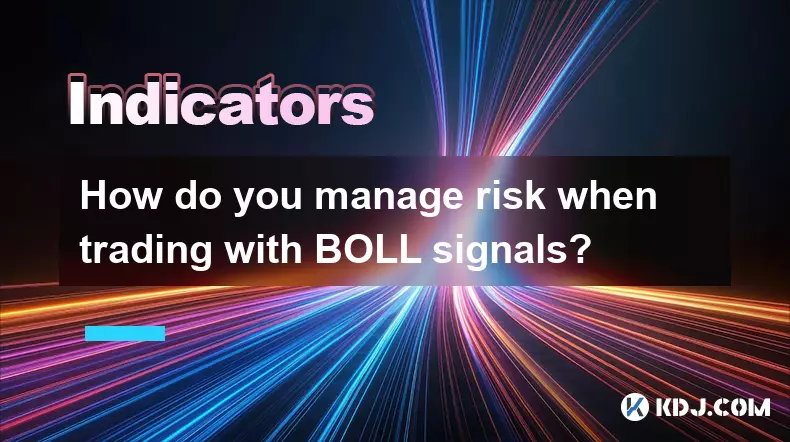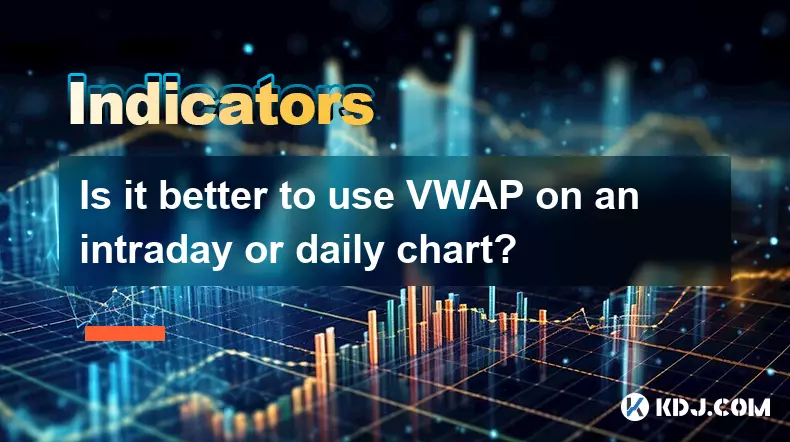-
 bitcoin
bitcoin $112715.707551 USD
-1.71% -
 ethereum
ethereum $4101.475385 USD
-3.01% -
 tether
tether $1.000644 USD
-0.02% -
 bnb
bnb $1207.619465 USD
-6.77% -
 xrp
xrp $2.501451 USD
-3.98% -
 solana
solana $202.947124 USD
-3.32% -
 usd-coin
usd-coin $1.000295 USD
0.04% -
 dogecoin
dogecoin $0.203884 USD
-4.47% -
 tron
tron $0.317154 USD
-1.72% -
 cardano
cardano $0.695009 USD
-4.43% -
 hyperliquid
hyperliquid $38.853961 USD
-8.23% -
 chainlink
chainlink $18.988674 USD
-4.64% -
 ethena-usde
ethena-usde $1.000233 USD
-0.03% -
 stellar
stellar $0.337050 USD
-3.63% -
 bitcoin-cash
bitcoin-cash $536.861728 USD
-1.28%
How do you manage risk when trading with BOLL signals?
Combine Bollinger Band signals with volume, RSI, and volatility filters to reduce false entries and improve risk-adjusted returns in trending or choppy markets.
Oct 14, 2025 at 10:18 pm

Risk Management Strategies When Using BOLL Signals
1. Setting predefined stop-loss levels based on Bollinger Band width helps traders limit potential losses when price action moves against their position. By placing the stop just beyond the outer band, traders align their risk parameters with market volatility as reflected by the bands.
2. Position sizing should be adjusted according to the distance between the upper and lower bands. During periods of narrow bands—indicating low volatility—traders may reduce position size anticipating a breakout. Conversely, wider bands suggest higher volatility, warranting caution even if the signal appears strong.
3. Avoid entering trades solely on price touching the upper or lower band without confirmation from volume or momentum indicators like RSI or MACD. Relying exclusively on band touches increases false signal risk, especially in trending markets where price can ride along one band for extended periods.4. Monitoring the slope and direction of the middle SMA (20-period) within the Bollinger Bands provides context. A steeply rising moving average suggests strong bullish momentum, making lower band bounces more reliable. In contrast, during sideways movement, range-bound strategies with tighter risk controls are more appropriate.
5. Traders should avoid holding positions through major news events when Bollinger Band signals have been triggered. Increased market noise during announcements can cause sharp band expansions and whipsaws, leading to unexpected slippage and margin calls.
Volatility-Based Exit Tactics
1. When the price moves rapidly toward the upper or lower band and then begins to reverse, it may indicate short-term exhaustion. Exiting part of the position at the band edge reduces exposure while allowing room to re-enter if momentum resumes.
2. A sudden expansion in Bollinger Band width after a period of contraction often precedes sharp directional moves. Traders who entered during the squeeze should consider taking partial profits once the breakout occurs, securing gains before potential pullbacks.
3. Using trailing stops anchored to the middle band allows profitable trades to run while protecting capital. As the 20-period SMA evolves, the trailing reference point adjusts dynamically, keeping pace with trend progression without being overly sensitive to minor reversals.4. If price closes back inside the bands after breaching them, especially on high volume, it may signal a failed breakout. Closing or reversing the trade under such conditions prevents deeper drawdowns.
5. In highly volatile assets like meme coins, band breaches are frequent but often short-lived. Exits timed with candlestick reversal patterns near the bands improve precision compared to fixed profit targets.
Combining BOLL with Other Risk Filters
1. Integrating on-chain data—such as exchange outflows or active address growth—with Bollinger Band signals adds a fundamental layer. A buy signal coinciding with increased wallet activity carries more weight than one occurring amid declining network usage.
2. Time-based filters enhance reliability. For instance, signals forming at UTC 00:00 or during New York session open carry more significance due to higher liquidity, reducing the chance of spoofed moves.
3. Divergence between price action and Bollinger Band width can warn of weakening trends. If price reaches a new high but the band width is contracting, it reflects diminishing volatility push—this serves as an early risk alert to tighten stops or exit.4. Funding rates in perpetual futures markets should be cross-checked. A long signal near the lower band may seem valid, but if funding is deeply negative, it could reflect capitulation rather than accumulation—prompting stricter risk limits.
5. Correlation with Bitcoin’s BOLL structure matters. Many altcoins follow BTC’s volatility cycles. Entering an altcoin trade counter to BTC’s band phase increases systemic risk, especially during broad market squeezes.
Frequently Asked Questions
What does a narrow Bollinger Band indicate for crypto traders?A narrow band suggests low volatility and often precedes a sharp price move. Traders watch for the “squeeze” pattern, where subsequent breakouts can lead to significant directional momentum, requiring careful position entry and immediate risk control.
Can Bollinger Bands be used effectively on 5-minute charts in crypto?Yes, but with heightened risk. Short timeframes amplify noise and false signals. Success requires combining BOLL with order book depth and volume spikes to filter authentic moves from transient fluctuations.
How should leverage be adjusted when trading BOLL signals?Leverage must be reduced during band contractions or when price hovers near upper/lower extremes. High leverage amplifies losses during reversals or fakeouts, particularly in illiquid altcoin markets.
Is mean reversion a reliable strategy using Bollinger Bands in bull markets?Not consistently. In strong uptrends, price often rides the upper band, making mean-reversion entries risky. Instead, buying dips near the middle band with trend confirmation yields better results than fading upper band touches.
Disclaimer:info@kdj.com
The information provided is not trading advice. kdj.com does not assume any responsibility for any investments made based on the information provided in this article. Cryptocurrencies are highly volatile and it is highly recommended that you invest with caution after thorough research!
If you believe that the content used on this website infringes your copyright, please contact us immediately (info@kdj.com) and we will delete it promptly.
- Tokenization Takes Center Stage: SEC-Registered Stock Tokens Reshape Finance
- 2025-10-15 22:25:13
- Bitcoin Seized, Transferred: A New York Minute on Crypto's Wild Ride
- 2025-10-15 22:25:13
- Milk & Mocha's $HUGS: Can This Crypto Presale Deliver a 100x Portfolio?
- 2025-10-15 22:30:01
- Memecoins Grow Up: $HUGS Presale Offers Real Utility
- 2025-10-15 22:45:13
- HUGS Launch, Crypto Bull Run, and a Perfect Storm Brewing?
- 2025-10-15 22:45:13
- Zero Knowledge Proof, Whitelists, and the Future of Blockchain Privacy
- 2025-10-15 22:30:01
Related knowledge

What's the main difference between VWAP and TWAP?
Oct 12,2025 at 11:54am
Understanding VWAP and Its Role in Crypto Trading1. Volume Weighted Average Price (VWAP) is a trading benchmark that calculates the average price of a...

How do you identify exhaustion moves using VWAP and its bands?
Oct 12,2025 at 08:00am
Understanding the Role of Decentralized Exchanges in Crypto Trading1. Decentralized exchanges (DEXs) operate without a central authority, allowing use...

Is it better to use VWAP on an intraday or daily chart?
Oct 15,2025 at 02:01am
Intraday Trading and the Role of VWAP1. Intraday traders frequently rely on VWAP (Volume Weighted Average Price) as a dynamic benchmark for assessing ...

How do you use VWAP to scale in and out of positions?
Oct 14,2025 at 02:19am
Understanding VWAP as a Dynamic Benchmark1. The Volume Weighted Average Price (VWAP) is not just an indicator—it functions as a dynamic benchmark that...

What are the main advantages of using VWAP over EMA?
Oct 11,2025 at 02:18am
Main Advantages of Using VWAP Over EMA1. Volume-Weighted Average Price (VWAP) incorporates trading volume into its calculation, offering a more accura...

How do you use VWAP on different chart types like Heikin Ashi?
Oct 11,2025 at 05:01pm
Understanding VWAP in the Context of Heikin Ashi Charts1. The Volume Weighted Average Price (VWAP) is a powerful analytical tool commonly used by trad...

What's the main difference between VWAP and TWAP?
Oct 12,2025 at 11:54am
Understanding VWAP and Its Role in Crypto Trading1. Volume Weighted Average Price (VWAP) is a trading benchmark that calculates the average price of a...

How do you identify exhaustion moves using VWAP and its bands?
Oct 12,2025 at 08:00am
Understanding the Role of Decentralized Exchanges in Crypto Trading1. Decentralized exchanges (DEXs) operate without a central authority, allowing use...

Is it better to use VWAP on an intraday or daily chart?
Oct 15,2025 at 02:01am
Intraday Trading and the Role of VWAP1. Intraday traders frequently rely on VWAP (Volume Weighted Average Price) as a dynamic benchmark for assessing ...

How do you use VWAP to scale in and out of positions?
Oct 14,2025 at 02:19am
Understanding VWAP as a Dynamic Benchmark1. The Volume Weighted Average Price (VWAP) is not just an indicator—it functions as a dynamic benchmark that...

What are the main advantages of using VWAP over EMA?
Oct 11,2025 at 02:18am
Main Advantages of Using VWAP Over EMA1. Volume-Weighted Average Price (VWAP) incorporates trading volume into its calculation, offering a more accura...

How do you use VWAP on different chart types like Heikin Ashi?
Oct 11,2025 at 05:01pm
Understanding VWAP in the Context of Heikin Ashi Charts1. The Volume Weighted Average Price (VWAP) is a powerful analytical tool commonly used by trad...
See all articles










































































